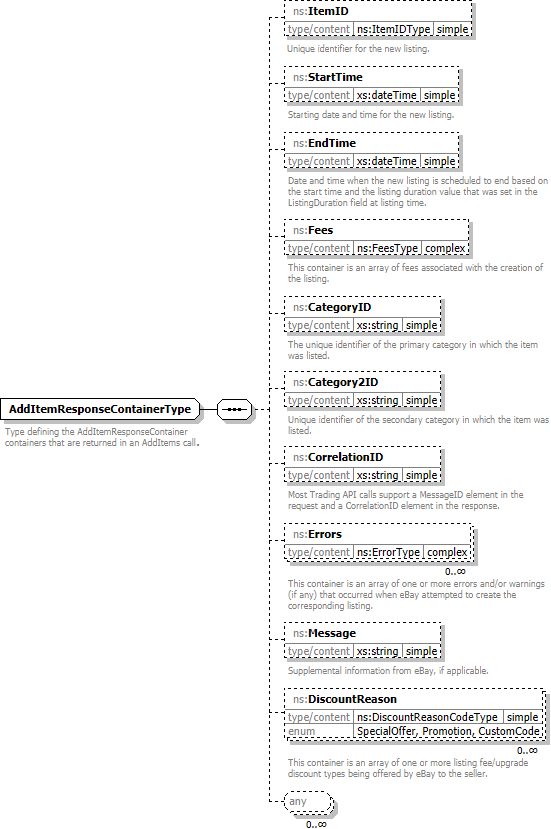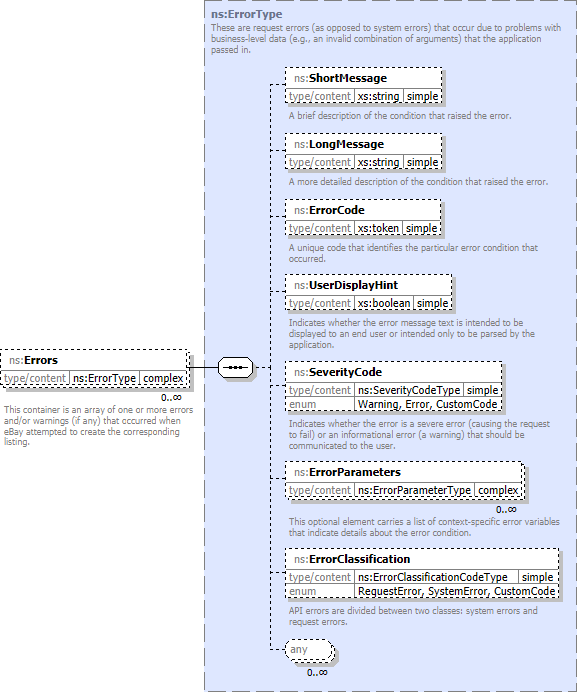
|
eBay Trading API |
|||||||||||||
Namespace: |
|
Content: |
|
Defined: |
|
Includes: |
|
Used: |
at 1 location |

XML Representation Summary |
|||
<...> |
|||
|
|||
</...> |
|||
|
<xs:sequence>
<xs:element minOccurs="0" name="ItemID" type="ns:ItemIDType"/>
</xs:sequence>
<xs:element maxOccurs="unbounded" minOccurs="0" name="DiscountReason" type="ns:DiscountReasonCodeType"/>
<xs:any maxOccurs="unbounded" minOccurs="0" processContents="lax"/>
</xs:complexType>
|
Type: |
xs:string, predefined, simple content
|
true in the request (or omitted) and the Category ID passed in as the secondary listing category was automatically mapped to a new Category ID by eBay. If the secondary category ID passed in the request is still active/valid, this field is not returned.
true if omitted. Previously, the default value was false, so a user had to include this field and set it to true in order for eBay to map an outdated Primary or Secondary Category ID to the updated Category ID.
|
||||||||
Type: |
xs:string, predefined, simple content
|
true in the request (or omitted) and the Category ID passed in as the primary listing category was automatically mapped to a new Category ID by eBay. If the primary category ID passed in the request is still active/valid, this field is not returned.
true if omitted. Previously, the default value was false, so a user had to include this field and set it to true in order for eBay to map an outdated Primary or Secondary Category ID to the updated Category ID.
|
||||||||
Type: |
xs:string, predefined, simple content
|
|
||||||||
Type: |
ns:DiscountReasonCodeType, simple content
|
|
||||||||
|
<xs:element maxOccurs="unbounded" minOccurs="0" name="DiscountReason" type="ns:DiscountReasonCodeType"/>
|
Type: |
xs:dateTime, predefined, simple content
|
GTC (Good 'Til Cancelled) this value will be set one month ahead of the start time, and this value will continue to be updated one month ahead each time the GTC listing needs to be renewed. Fixed-price listings get renewed automatically as long as there is still a quantity of 1 or above, or even if the quantity is 0, but the 'out-of-stock control' feature is enabled.
GTC is not a supported listing duration for auction listings, but is the only supported listing duration for fixed-price listings except for a few motor vehicle categories on eBay Motors US, eBay UK, and eBay Italy.
|
||||||||
Type: |
ns:ErrorType, complex content
|

|
||||||||
Type: |
ns:FeesType, complex content
|
USD and not CAD.

|
||||||||
Type: |
ns:ItemIDType, simple content
|
|
||||||||
Type: |
xs:string, predefined, simple content
|
|
||||||||
Type: |
xs:dateTime, predefined, simple content
|
|
||||||||
|
<xs:any maxOccurs="unbounded" minOccurs="0" processContents="lax"/>
|
|
eBay Trading API |
|||||||||||||
WSDL documentation generated with FlexDoc/XML 1.13 using FlexDoc/XML WSDLDoc 1.2.5 template set. All XSD diagrams generated by FlexDoc/XML DiagramKit. |